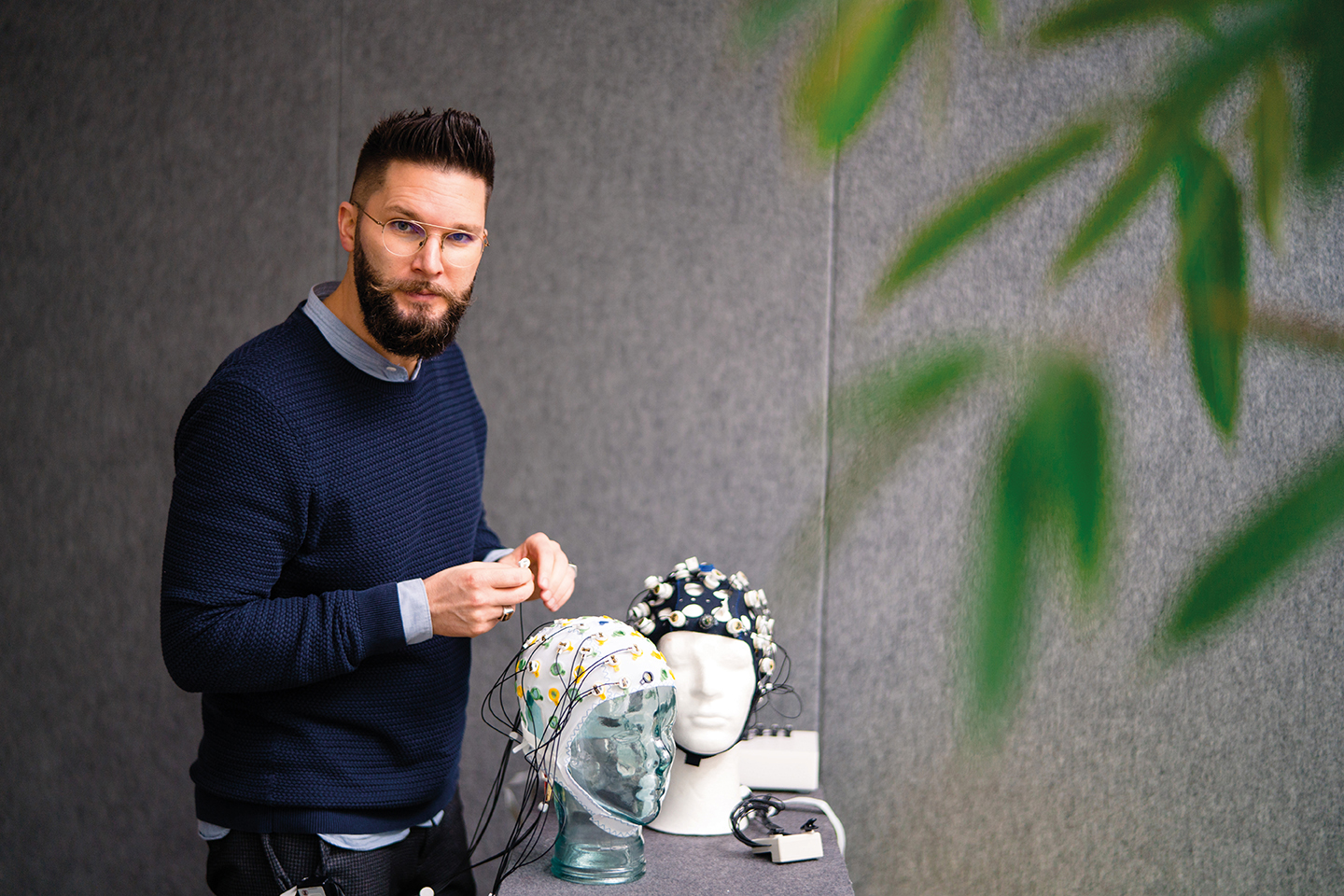Focusing on the human aspect

How does our brain work? Dr. Mathias Vukelic wants to understand how cognition and emotion interact in the human brain. At Fraunhofer IAO, the neuroscientist is developing technologies that can help people in their daily lives.
Dr. Vukelic has always been fascinated by the human brain. He wanted to know how thinking works, what influence emotions have on human behavior, and how cognition and emotion interact. Throughout his studies in biomedical engineering at the Saarland University of Applied Sciences and his doctorate in neuroscience and behavioral sciences at the University of Tübingen, he primarily focused on the question of how humans and machines could work together. For seven years now, the 36-year-old has been working at Fraunhofer IAO, where he is using a combination of cognitive neuroscience, positive psychology and machine learning to find the answer to the question: How can technology be designed so that it is easier for people to use?
Since October 2021, Vukelic has headed the recently founded Applied Neurocognitive Systems department. Here, the neuroscientist and his team are studying human physiological processes such as heart and brain activity and perspiration — and not just in the low-stimulus environment of the laboratory either but primarily in realistic situations in which different stimuli affect the body’s various senses. The researchers can then draw conclusions about cognitive processes and emotional experiences from the cerebral and physical responses measured. For example, they are investigating what the interior of a fully autonomous car needs to look like in order for passengers to be able to utilize the time spent in the vehicle as productively as possible. To that end, they are testing different lighting conditions and background noises, for example. “It is important to consider the emotional experience when designing technology. Technical applications must not be a burden or a nuisance to people,” says Vukelic. Technology should be pleasant to use, give people pleasure and help them to make better decisions as well as improve how they learn and communicate, facilitating personal development.
“It’s about focussing on the human aspect,” explains Vukelic, a point he repeatedly emphasizes. “It is not about finding technical solutions just because we can.” For that reason, he often asks a difficult question in his research: How does technical equipment change people? Does it help us progress or not?
The latest project that Vukelic and his team are working on is called “UFO” and is funded by the German Federal Ministry of Education and Research (BMBF). UFO has nothing to do with “unidentified flying objects” but rather the use of virtual reality to promote professional inclusion — in particular for people with autism spectrum disorder (ASD), a far-reaching developmental disorder that usually appears in the first three years of life. Those with the disorder have difficulty understanding their own feelings as well as those of others. What does anger feel like? How do you express joy? People with ASD struggle to decipher emotions.
Vukelic and his team are now working to help people with ASD to understand emotions, to an extent, in a roundabout way. This is made possible by measuring heart and brain activity, perspiration and other physiological processes that take place in connection with emotions, and then making these perceptible through pulses emitted by a special wristband. People with ASD could learn the tactile patterns produced by the wristband, which would enable them to tap into their own feelings. This is initially coached in a virtual learning and experience space, but, in principle, the technology can also be applied in reality. And Vukelic is already thinking ahead: “The first step is being able to tap into our own emotions. The second is to then make it possible to experience the emotions of our fellow human beings in this way.”
Lab demo: a tour of the NeuroLab
In the video, Katharina Lingelbach gives an insight into the work carried out at the NeuroLab at Fraunhofer IAO and shows how the Applied Neurocognitive Systems team and herself use various measurement methods, test setups and neuroadaptive technologies to measure and analyze cognitive states of test subjects.
NeuroLab — a test environment for occupational neuroscience issues
In October 2015, Fraunhofer IAO opened a test environment for occupational neuroscience issues in the form of the NeuroLab.
(Note: Both videos are in German.)